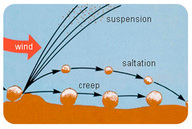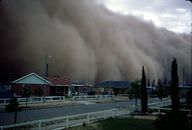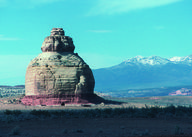14.9: Erosion by Wind
- Page ID
- 5571
Is wind the greatest erosional force in the desert?
Wind can do remarkable things. It can erode rock to make beautiful shapes. Wind has eroded this rock so that it looks like a rabbit. This limestone formation is in the Sahara Desert in Egypt. Water is the most important erosional force even in the desert. But wind makes its mark in many ways.
Sediment Transport by Wind
Like flowing water, wind picks up and transports particles. Wind carries particles of different sizes in the same ways that water carries them (Figure below).
- Tiny particles, such as clay and silt, move by suspension. They hang in the air, sometimes for days. They may be carried great distances and rise high above the ground.
- Larger particles, such as sand, move by saltation. The wind blows them in short hops. They stay close to the ground.
- Particles larger than sand move by creep. The wind rolls or pushes them over the surface. They stay on the ground.
Wind transports particles in different ways depending on their size.
Wind Erosion
Dust storms (Figure below) are more common in dry climates. The soil is dried out and dusty. Plants may be few and far between. Dry, bare soil is more easily blown away by the wind than wetter soil or soil held in place by plant roots.
When winds whip up in the desert, they can create tremendous dust storms.
Deflation
Wind blows small particles away. As a result, the ground surface gets lower and rockier; this is called deflation. The rocks that are left are called desert pavement. Desert pavement is a surface covered by gravel-sized particles that are not easily moved by wind.
Abrasion
Did you ever see workers sandblasting a building to clean it? Sand is blown onto the surface to scour away dirt and debris. Wind-blown sand has the same effect. It scours and polishes rocks and other surfaces. Wind-blown sand may carve rocks into interesting shapes (Figure below). This form of erosion is called abrasion. It occurs any time rough sediments are blown or dragged over surfaces. Can you think of other ways abrasion might occur?
This incredible rock formation in Utah is the result of wind erosion.
Desert Varnish
Exposed rocks in desert areas often develop a dark brown or black coating called desert varnish (Figure below). Wind transports clay-sized particles that chemically react with other substances at high temperatures. The coating is formed of iron and manganese oxides.
Ancient people carved these petroglyphs into desert varnish at Sego Canyon, Utah.
Further Reading
Deposition by Wind
Summary
- Wind moves sediments by suspension, saltation, or creep.
- In deserts, wind picks up small particles and leaves behind larger rocks. This forms desert pavement.
- Moving sand may sand blast rocks and other materials causing abrasion.
Review
- How does desert varnish form?
- Why are dust storms more common in deserts than in wetter regions?
- How does wind transport the smallest sediments? How does wind transport sand? How does wind transport particles somewhat larger than sand?
Explore More
Use the resource below to answer the questions that follow.
- Why is soil erosion a problem?
- How does wind erosion occur? What is the relationship between wind speed and the amount of erosion?
- What are the three types of wind erosion?
- What type of wind erosion moves 50% of the soil?
- What is creep?
- What is saltation?
- What is suspension?
- When is suspension easily seen?
- What has accelerated erosion?






